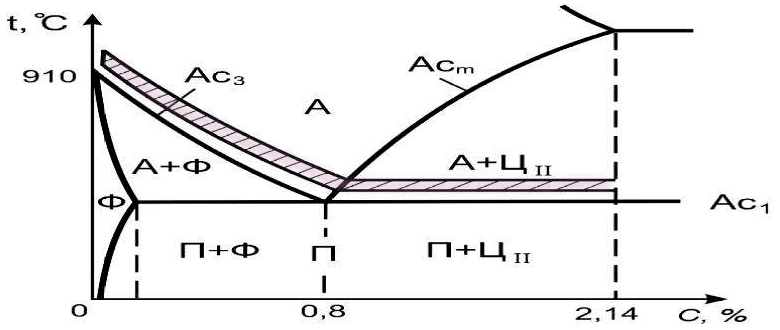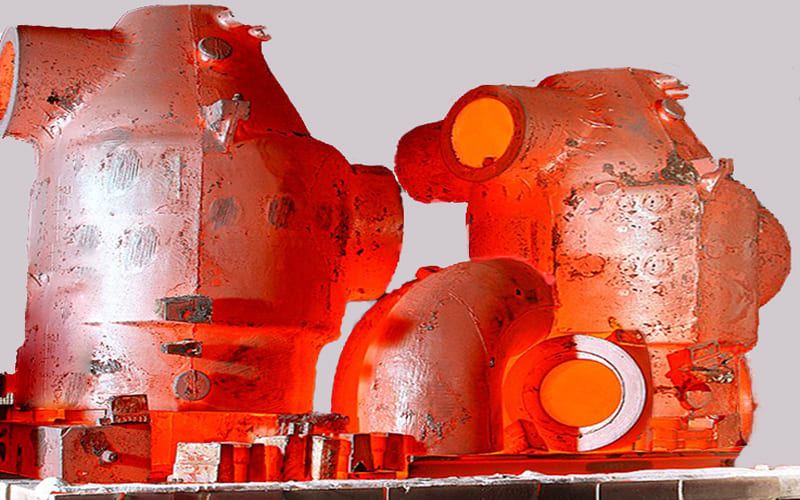Heat treatment of castings
Billets obtained by castings are the simplest, most reliable and, accordingly, common methods for obtaining workpieces of complex geometric shapes or when a workpiece is needed from specific grades of materials that are difficult to find for hire.
Castings can be obtained from almost any material: non-ferrous alloys, steels, cast irons, etc. In this article, we will consider the techniques improving the properties of castings by heat treatment methods. Casting technology involves melting the metal and pouring it into pre-prepared forms in a liquid (flowing) state. Microstructure cast and cooled blanks have a coarse-grained structure, mainly grains of large-lamellar pearlite or a ferrite grid. One of the most common defects is the Widmanstätt structure. Such a structure is formed with significant overheating at the time of pouring.
Due to the coarse-grained structure of internal stresses and other specific defects inherent in castings, the strength and the ductility of the cast steel is low, and the hardness is high, which does not complicate machining. The chemical composition is heterogeneous in structure, there is dendritic segregation.
Castings are heat treated to correct or minimize defects. Before heat treatment, the casting is cleaned and the sprues and sprues are cut off and only then sent for heat treatment. Heat treatment of castings is performed to relieve internal stresses, level, grind and change their structure in order to increase strength, plasticity, hardness, and their operational reliability. The high temperature promotes the intensification of diffusion rearrangements and bringing the structure into a form acceptable for further operation. This type of heat treatment is called annealing .

It is planned to heat the workpieces above the points Ac3 or Ac1, at (30-50 ° С) temperature holding followed by slow cooling.
The time for heating the castings for annealing is set by the formula: Totzh = (K*D) * 1.25
- Where K is a coefficient reflecting the approximate warm-up time, which is selected in the range of 1-2 minutes per 1 mm of section.
- D value is the diameter or the smallest dimension of the largest section of the product.
Additionally, it is necessary to take into account the time for diffusion rearrangements within 25% of the heating time.
Thus, if the casting is in the form of a rod with a diameter of 150 mm, then the annealing time will be approximately T = (1.5 * 150) * 1.25 = 281 min.
Billets of simple shape made of alloy steel are subjected to normalization followed by high tempering. If the parts are small, simple in shape, without significant variable sections, then they can be hardened, followed by tempering to the required hardness. The structure becomes finer after annealing or normalization.

Where: a) - heating slightly above the Ac1 point (partial formation of austenite); b) - heating above the Ac3 point (austenite with preservation of orientational bonds with the original structure); c) - the beginning of austenite recrystallization; d) - complete recrystallization.
Thin-walled castings for critical products
In practice, in order to minimize defects in castings with walls up to 25 mm made of carbon steels for particularly critical products, it is recommended to perform heat treatment in several stages. Initially, the workpiece is subjected to normalization with heating and holding up to 960-970 ° C, the next stage is quenching with cooling in water from a temperature of 840 ° C, followed by high tempering at 600 ° C. Heat treatment in several operations minimizes workpiece defects, but at the same time increases the cost of the product as a whole and must be economically justified.
Thick-walled castings for critical products
Products with a wall section exceeding 50 mm are subjected to normalization followed by high tempering, which allows to increase the impact strength by 1.5-2.0 times. To improve massive castings with a large dendritic structure and intracrystalline segregation, diffusion (homogenizing) annealing is carried out in the range temperatures 960-1000 ° C. The next step is traditional annealing or normalization.
Alloy steel castings for critical products
The presence of alloying elements in cast billets makes it difficult to crush a coarse-grained structure, therefore, alloyed steels are heated to higher temperatures of 1100-1150 ° C
To correct defects in castings, alloy steels are subjected to high-temperature annealing. Complete recrystallization of austenite occurs only at high temperatures. (рис. 1). To achieve high mechanical properties and good plasticity, heat treatment is carried out in several operations. Diffusion annealing or high temperature normalization is carried out initially with a long exposure, about 10-15 hours for the passage of diffusion processes. Then, conventional annealing is carried out at Ac3 temperature (30-50 ° C) in order to reduce grain size. Final properties and the hardness of alloy steels is obtained by quenching for oil, followed by tempering.
The heating schedule for quenching and tempering should be stepwise and take into account the temper brittleness.
To ensure uniform heating, the charge in the furnace is placed on special steel elevations relative to the hearth (bays), and the workpieces are recommended to be placed at an even distance relative to the burners.
The second desirable condition for efficient forging is the increased power of the forging furnaces compared to heat treatment furnaces. The closer the heating rate is to the permissible, the less time the process takes heating and, accordingly, less metal waste (scale) is formed, the decarburized layer and defects in the form of flakes are minimized. The grain size of the steel directly depends on the residence time of the workpiece at elevated temperatures.

Furnaces for heat treatment of castings or forgings practically do not differ from each other. Stoves can be cage or continuous , gas or electric. When choosing equipment, it is necessary to focus on the dimensions of the workpieces or productivity. Long-term annealing is recommended in a protective atmosphere. It is necessary to ensure uniform heating and stepwise. Bogie hearth chamber furnaces are the most popular for annealing in saddle furnaces. They, as a rule, have large dimensions, bottom heating is organized in them, which allows uniform heating, they are convenient for loading and unloading, they allow for stepwise heating and controlled cooling. Continuous annealing furnaces are very diverse and, as a rule, are made for specific production conditions and types of products.
(the territory of JSC "Ural plant RTI")


